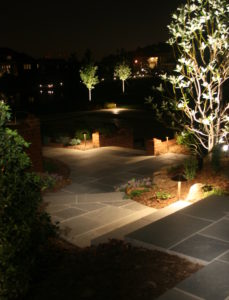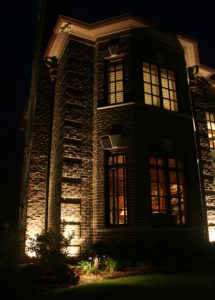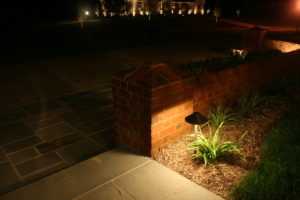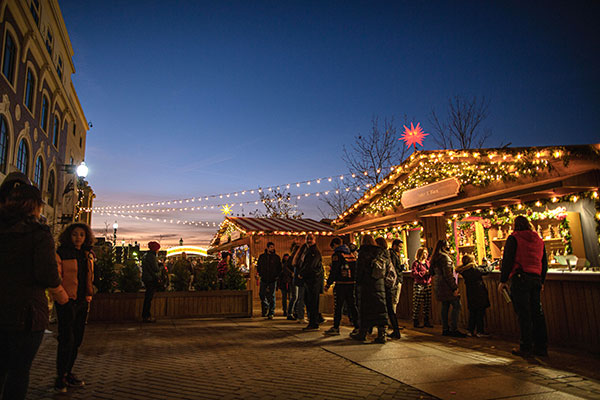Landscape lights are a great investment for many people. They add beauty and security to your home, helping you enjoy your landscape all night—and all year. Modern landscape lights are more efficient, safer, and have more options than ever before, so we wanted to give you a quick rundown of what you should know before you get started with your design.
are a great investment for many people. They add beauty and security to your home, helping you enjoy your landscape all night—and all year. Modern landscape lights are more efficient, safer, and have more options than ever before, so we wanted to give you a quick rundown of what you should know before you get started with your design.
Decades ago, landscapes were lit by high-voltage incandescent lights that were inefficient, expensive, required lots of maintenance, and had the potential to be unsafe since high-voltage electricity and wet landscapes aren’t a good mix. Years later, low-voltage lights became a much safer, more popular option, but they still had many of the same problems as their high-voltage counterparts.
Today’s landscape light of choice is the LED (Light Emitting Diode). LEDs provide many advantages over incandescent lights, including a 70 to 80 percent reduction in energy consumption. They don’t use bulbs, so you don’t need to worry about them burning out, and they can last for years without needing to be repaired or replaced. That means saving money on both electricity and maintenance.
When placing outdoor lights, you need to look at three different aspects of your visual concept:
 Architectural lighting. Your home is the backdrop for your lighting setup, and the base of your visual concept—using light to appropriately accentuate its features is key. Tall archways, pillars, brick facades, and other unique architectural points or hardscaping features can be dramatically enhanced with the right lights in the right places.
Architectural lighting. Your home is the backdrop for your lighting setup, and the base of your visual concept—using light to appropriately accentuate its features is key. Tall archways, pillars, brick facades, and other unique architectural points or hardscaping features can be dramatically enhanced with the right lights in the right places.
Landscape lighting. Knowing which flowers, trees, and shrubs to illuminate—and how to position lights correctly—is key to getting the most out of your design. You also have the opportunity to make creative choices that provide interesting visuals, like lighting plant material so it casts a silhouette against the side of the home.
It’s important to note that there are certain plant types you’ll want to stay away from when lighting your landscape. While deciduous trees (including trees with large or small leaves, shade, and ornamental trees) can be a great target for lights, coniferous trees (like evergreens and pines) aren’t ideal since they tend to block or knock down light.
Security and safety lighting. Bright landscape lighting can deter trespassers, so you’ll want to consider where to place lights from a security perspective. Lighting can also make your property safer when you add lights to steps, walkways, and hard-to-see areas.
Advancements in technology have given us lots of new options when it comes to controlling your lighting system. Astronomic timers are now a popular choice for new lighting systems—they’re basically digital timers that account for the date, time, and geographic location, and they turn lights off and on according to your settings.
 These settings can be quite simple, like turning your lights on at sunset and off at sunrise. Or they can be more complicated, like creating a different lighting schedule based on holidays or weekends, or changing the intensity of the light being emitted. You can even get LED lighting options that allow you to change the color of the lights.
These settings can be quite simple, like turning your lights on at sunset and off at sunrise. Or they can be more complicated, like creating a different lighting schedule based on holidays or weekends, or changing the intensity of the light being emitted. You can even get LED lighting options that allow you to change the color of the lights.
When designing and creating your outdoor lighting setup, it’s always best to work with a professional. While you can buy exterior lights at your local big-box store, these lights aren’t the same quality you’ll get from an experienced landscape contractor like Engledow. Professional grade equipment lasts longer, is more efficient, and saves you money in the long run—in fact, an LED system will pay for itself within five to seven years on energy savings alone.
If you’re interested in creating a plan for lighting your landscape, winter is a great time to get started. Having your plan ready by spring means you’ll be able to start enjoying your illuminated landscape right when the weather gets nice. If you want to learn more, contact us today for a free consultation.

